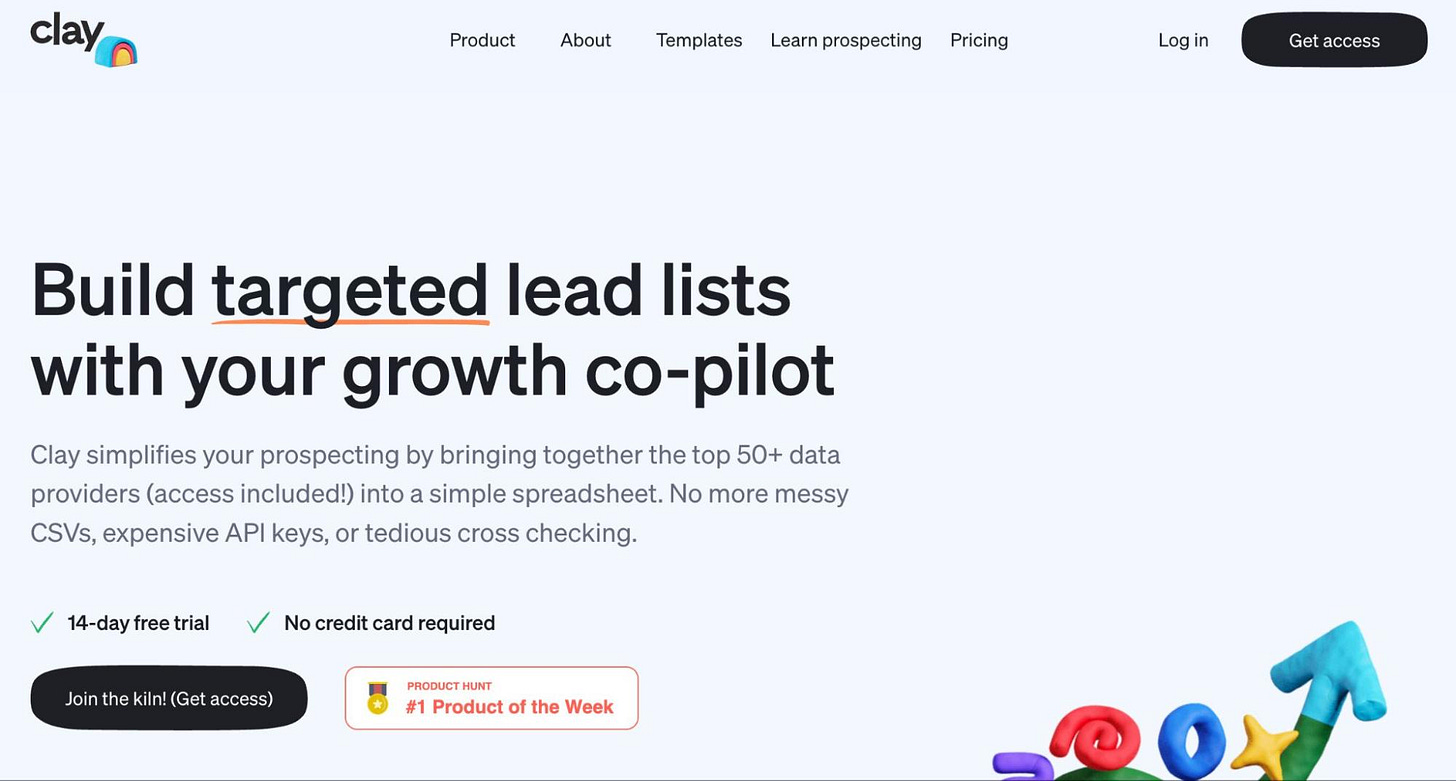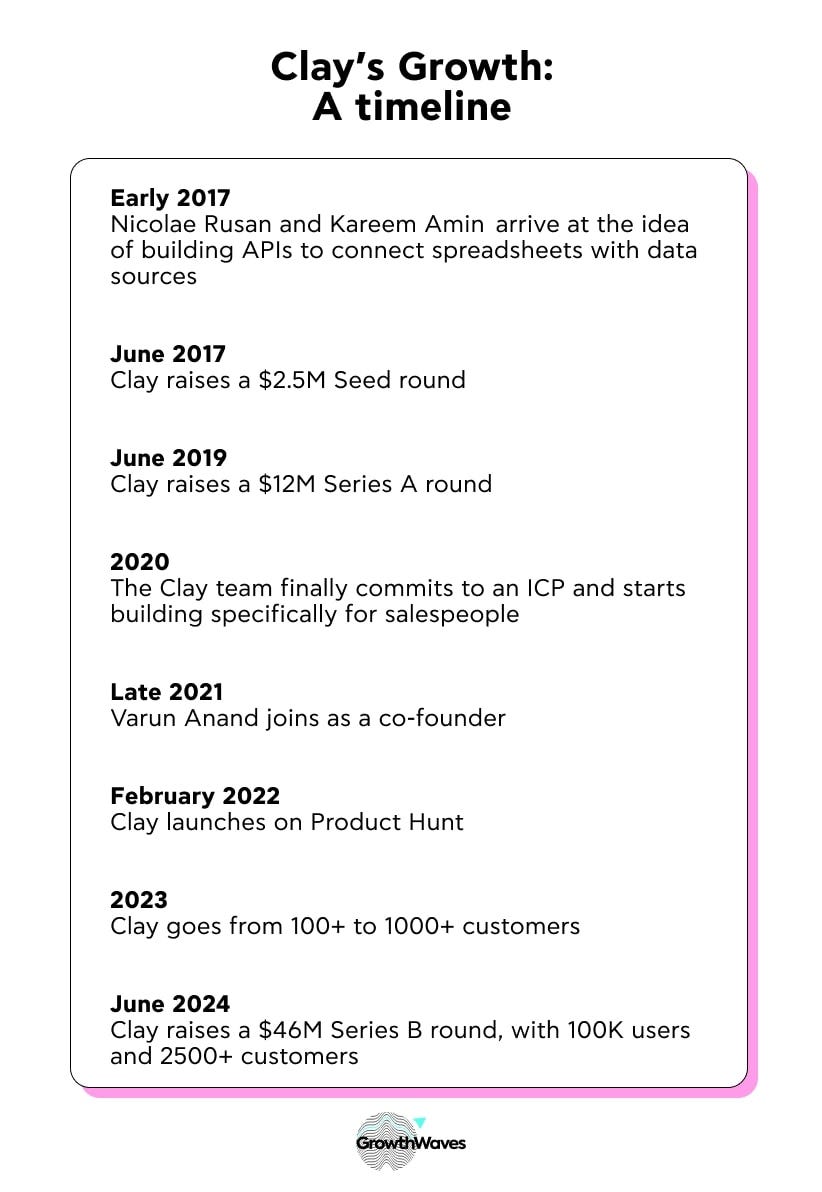The secrets behind a $500M growth strategy
The 7-year journey behind Clay’s ‘overnight success’
👋 Hey, I’m George Chasiotis. Welcome to GrowthWaves, your weekly dose of B2B growth insights—featuring powerful case studies, emerging trends, and unconventional strategies you won’t find anywhere else.
Since its launch on Product Hunt in February 2022, Clay has gained over 100K users and was recently valued at $500M.
It would be easy to consider the product an ‘overnight success’, but we all know that’s not how things typically go in the SaaS industry.
In fact, Clay’s success has been seven years in the making.
In today’s Note, I want to explore the three key drivers that led to Clay becoming the B2B triumph it is today.
Let’s dig in.
Key findings (TL;DR)
It took Clay nearly 5 years to commit to an ICP. Their stratospheric growth didn’t start until the moment they finally narrowed down their value proposition.
Clay had to invent a new product category for itself. Since it couldn’t replace a CRM or a lead contacting tool, it had to carve out space for itself in between them in the outbound sales process.
Product-led growth was driven by customer calls. One of Clay’s co-founders, Varun Anand, dedicated months of his time to back-to-back customer calls until the product sign-up flow was polished to shine.
Product evangelism began with a Slack channel. One place where all of Clay’s users gathered to share experiences and knowledge and interact with the support teams.
Clay continues to invest in its community. Through bootcamps, cohort programs, in-person events, personalized touches, job boards, and more, Clay ensures that its community is supported and thriving.
Short history
Clay is a data enrichment and outreach automation tool geared towards outbound sales teams.
Essentially, you load it up with prospect data from your CRM or other source(s) and use the 75+ data enrichment tools its connected with to find more data – anything from your prospects’ personal emails, work emails, mobile phone numbers, to their company’s total funding, tech stacks, dates of founding, and more.
All of that data can then be used – with the power of AI writing – to craft personalized outbound messages to your prospects.
You can understand how software as powerful as this can quickly become invaluable to a sales team.
However, the first kernel of an idea for Clay wasn’t always meant to be a sales product, as we’ll explore more in-depth later.
Two of Clay’s three co-founders, Kareem Amin and Nicolae Rusan, first envisioned it as a spreadsheet connected with APIs that would enable non-developer people to build software products as easily as experienced software engineers.
It wasn’t until 2020 – three years after the superpowered spreadsheet idea came about – that they started narrowing in on their sales and marketing ICP.
Clay’s third co-founder, Varun Anand, joined the team in late 2021 to lead their GTM efforts, and the whole idea truly started taking shape.
Here is a visual timeline of Clay’s seven-year long journey from inception to today.
Key drivers of Clay’s growth
The three biggest drivers of Clay’s growth have been:
The painstaking refinement of their targeting until they pinned down their ICP.
Nailing down the right, category-defining positioning, and zeroing in on PLG.
Their evangelical user community is well-supported and cultivated by Clay itself.
Let’s take a closer look at each of these.
Driver #1: Painstakingly established product-market fit
One problem that Clay ran into early on was that the concept of an API-backed spreadsheet was almost too flexible.
It could be used to find job candidates, for inbound and outbound sales, as a low-code backend for front-end developers… They even had an early customer who used Clay in conjunction with their accounting software.
In light of all these possibilities, Amin and Rusan had trouble focusing the product.
This ping-ponging was reflected in their 2020 homepage value proposition, which didn’t commit to any one specific ICP:

Even when Rusan suggested prospecting as a primary use case for Clay, they still found themselves getting sidetracked by other possibilities.
“We would make a decision to target salespeople. Then we would get sidetracked, pursue another type of user, and then we’d come back to the same spot. And we’d realize, ‘Oh, this is why we made that decision in the first place,’ and then we’d commit to it again. It took a couple of turns,” Amin said in this interview with Todd Jackson.
“When you narrow the scope, it feels claustrophobic. Why are we doing something that’s smaller when we could be doing something bigger? Eventually, we realized that by narrowing down our scope, we were actually increasing our value.”
In 2021, their homepage first included a value proposition aimed at sales teams:

This meandering journey of finding the right product-market fit for Clay led Amin to define two key steps in the process, which could be applied to any early-stage SaaS:
Know when to be malleable. In its infancy, your SaaS product can become anything – make the best of that flexibility until you define what it is.
Know when to stop being malleable. When you define the product and are ready to go to market, ditch the flexibility.
Here’s how Amin puts it:
It’s almost like there are two distinct phases. You can be malleable when you're defining what the product is, but once you’ve taken a pass at that, you need to harden it when you try to go out to market. You can’t be changing the value prop or even the product itself from meeting to meeting.
All of this led to Clay finally redesigning their homepage to include their ICP in 2022:

Driver #2: Inventing a new product category and focusing on PLG
Clay wasn’t supposed to replace a CRM. It also couldn’t (and wouldn’t) be used to directly contact leads.
It had to sit between these two – the CRM and the contacting software (typically an email platform) – and interact with them both.
This means Clay had to invent a new product category for itself.
This is where Anand came in, as the key person to drive Clay’s product-led growth and help it establish itself in this new category it created.
To say that Anand gave it his all would be an understatement.
According to his friend Evan Armstrong who wrote about Anand joining Clay, Anand was meticulous and unrelenting about perfecting the product.
...he spent months in back-to-back customer calls. He would walk them through the product live, screenshot every bug, and share each one in Slack. He did this over and over again until there weren’t any more hitches in the sign-up flow to send to the product team.
For Anand, the product was the star. The product was what made him excited to join the project as a co-founder.
The product was bold, powerful, and disruptive, and he wanted everyone else to see it, too.
And they did.
It wasn’t long before Clay started gathering fanatical early adopters who succeeded in bringing in the rest of the market through good old-fashioned product evangelism.
Of course, Clay helped them along the way, eventually establishing a community that has been growing at a staggering rate.
Driver #3: A strong user community
It started with a Slack community.
Amin had the idea of gathering all of their users in one place and making it the only place anyone could reach Clay support.
Before that, you would email us or chat like most startups. But we pushed all of our customers into the same channel.
The Slack community had only about 200 people in the beginning. Today, it has more than 13K+ users, all eagerly sharing their insights into using Clay, asking for help from the support teams, reporting bugs, and providing tips and tutorials to other users.
In fact, this concept of proficient Clay users helping others make the most of Clay lead to the development of Clay experts. Here’s what Amin told Todd Jackson about that:
We started seeing people call themselves Clay experts and try to help other people get set up on Clay. There are dozens of Claygencies — agencies that specialize in implementing Clay for customers — some of which have a run rate of over $2M/year, which is wild.
While Clay isn’t incredibly difficult to use, it isn’t the most straightforward tool either – looking for specific data can get complicated pretty quickly if one isn’t sure what they’re doing.
One Clay Expert theorizes that it is precisely this complexity that gave birth to Clay Experts and strengthened the community as a whole:
Furthermore, the Clay team started noticing that more and more open job descriptions started listing Clay as a required tool to be familiar with.
They capitalized on that by launching a Clay-specific job board, where companies can submit job listings and job-seekers can get matched with roles that fit their skill sets.
Here are some other ways Clay contributes to its user community, helping it grow:
Establishing a Clay for Creators affiliate program.
Here’s what a Clay user says about Clay and participating in their affiliate program:

Organizing bootcamps (while showcasing their values in the process).

Providing personalized touches to dedicated Clay Experts.

Organizing Cohort programs for those who want to learn how best to use Clay and meet other ‘Claymakers’.
By providing their users not only with ample material for learning how to use the tool and peers eager to exchange experiences, but also with a way to earn money by offering Clay services to others, I expect Clay’s community will not be slowing down any time soon.
Conclusion
One of the biggest challenges of any product (especially a SaaS one) is generating hype and getting a large number of people excited about it enough to start talking about it.
This feat may seem like it is largely out of our control, but Clay’s example proves differently.
They:
Conducted a seemingly never-ending stream of customer calls before they pinpointed a use case for their product that their customers were genuinely interested in.
Refined their product to fully support that use case and their PLG strategy.
Created a space for their community to start gathering in and nurtured any new seeds of community evolution that were planted there.
Thank you for taking the time to read this week’s GrowthWaves Note.
See you next week!



